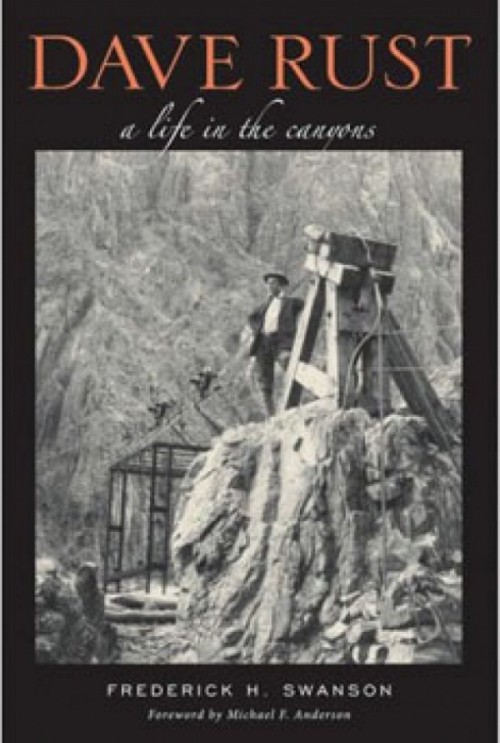Books | Inside Out: Two new biographies explore bringing Utah to the rest of the world
By Geoff GriffinThe two had much in common. In Dave Rust: A Life in the Canyons, Frederick H. Swanson even uses a quote from Stegner to describe Rust being “shaped by the bigness, sparseness, space, clarity and hopefulness of the West.” Rust was an educator, publisher and legislator, among other things, but what makes him biography-worthy is that he was one of the first to show the rest of the world the beauty of the Colorado Plateau, particularly Glen Canyon and the North Rim of the Grand Canyon. In 1923, he began a river-guide service on the Colorado River, and he would continue to be an outfitter and guide for over three decades.
Rust was more than just a back-country hick who knew where the trails were. He studied at Brigham Young Academy (the forerunner of BYU) and had even done a year at Stanford. In his own description of his job, Rust said, “A thorough traveler must be something of a geologist, something of a botanist, an archaeologist, an artist, a philosopher, and so on,” and he fit the bill.
As Swanson notes, “In the first few decades of the 20th century, many travelers were looking for some relics of the Old West—a crusty Grand Canyon prospector, a taciturn cowhand with a flair for roping, or perhaps a weathered outfitter full of extravagant yarns. What people … found when they stepped off the train and met Dave Rust was altogether different. He was a native son, to be sure, but he had an extraordinary thirst for knowledge, and a rare ability to impart his learning to others.”
Rust was also the perfect ambassador for the Colorado Plateau because he took the attitude, “You must love my country. … I love it, and so must you.” He was ready to share the love any time anyone showed up looking for an adventure, and he was particularly adept at showing as well as explaining the sights to various dignitaries, big wigs, newspaper publishers, politicians and others from back East who could send the message out about the beauty to be found in southern Utah and northern Arizona. Swanson provides not only solid scholarship in terms of sources and citations but lively writing as well. His descriptions of the places Rust visited are vivid enough for the reader to picture in his or her mind.
Such mental picturing isn’t required in Wallace Stegner’s Salt Lake City, since Robert C. Steensma has provided 70 pages of black-and-white photos of the way the capital city looked around the 1920s to go along with two passages by Stegner and 58 pages of writing by Steensma.
In many ways, Stegner—the Pulitzer-Prize winning author and prolific writer of books such as Mormon Country and The Gathering of Zion: The Story of the Mormon Trail—ended up in the perfect situation to be able to write about the LDS people in a way the rest of the world would understand. He was a well-educated outsider who had nevertheless experienced Mormonism from the inside during his formative years.
Stegner once wrote, “The Mormons … had a strong sense of family and community, something the Stegners and the people they had lived among were notably short of. … I have never ceased to be grateful for what they gave us when what they gave us mattered a great deal; and though I was never tempted to adopt their beliefs, I could never write about them, when it came to that, except as a friend.”
Besides pointing out many interesting facts about Stegner’s time in Salt Lake City, Steensma also illustrates how Salt Lake was as much of a solid home base as Stegner ever had in his peripatetic life. “Salt Lake City was more than just a home for Stegner during the 14 years he lived there,” Steensma points out. “The city provided him with an education, matured him socially and intellectually, and gave him a rich fund of associations and memories to use in his fiction, his historical writing, and his environmental work.”
That’s a lot to get from one town in Utah. Thankfully, Stegner was able to let the rest of the world know about it.
DAVE RUST: A LIFE IN THE CANYONS, Frederick H. Swanson, University of Utah Press, 2007, 354 pages, $29.95, hardback
WALLACE STEGNER’S SALT LAKE CITY, Robert C. Steensma, University of Utah Press, 2007, 165 pages, $29.95, hardback
More by Geoff Griffin
-
A Family New Year
How to ring in 2020 with revelers of all ages.
- Dec 25, 2019
-
The 12 Arts of Christmas
A delightful dozen options for your holiday entertainment needs.
- Nov 27, 2019
-
Season Kickoff
A look at what's new, or old but great, at Utah's ski and snowboard resorts for the winter season.
- Nov 13, 2019
- More »
Latest in Arts & Entertainment
Readers also liked…
-
New TV for January 2023
Mayfair Witches, Velma, The Last of Us, Poker Face and more premieres
- Jan 4, 2023




